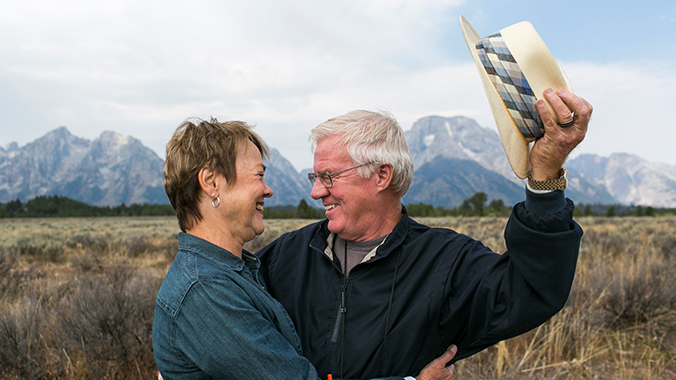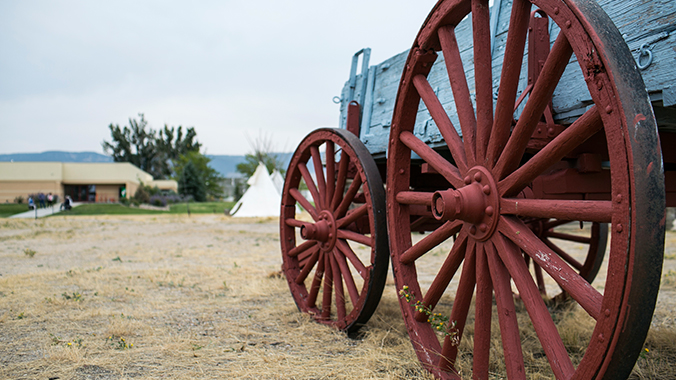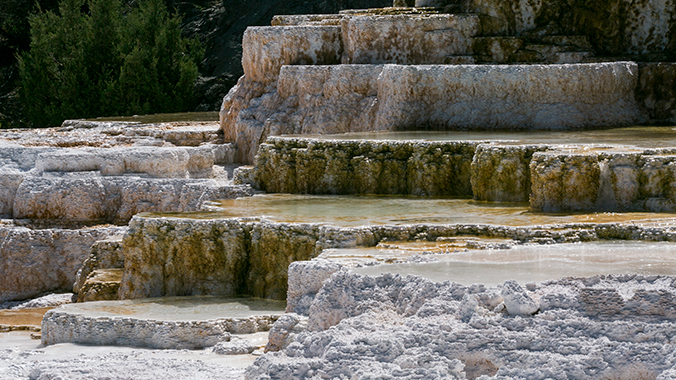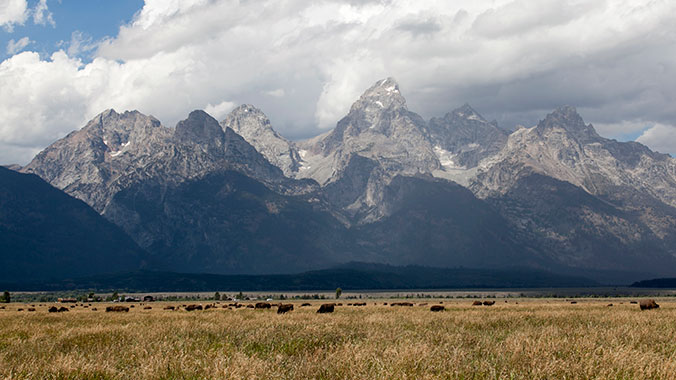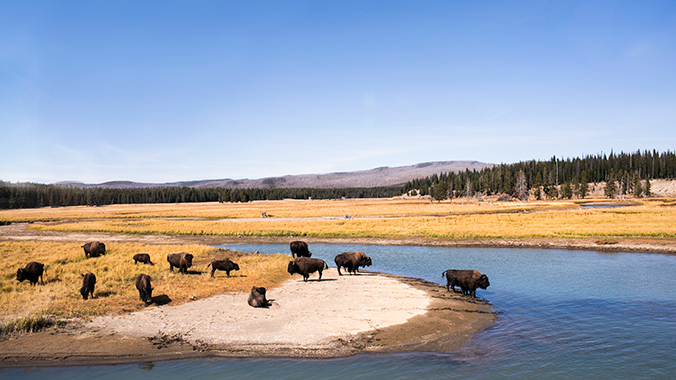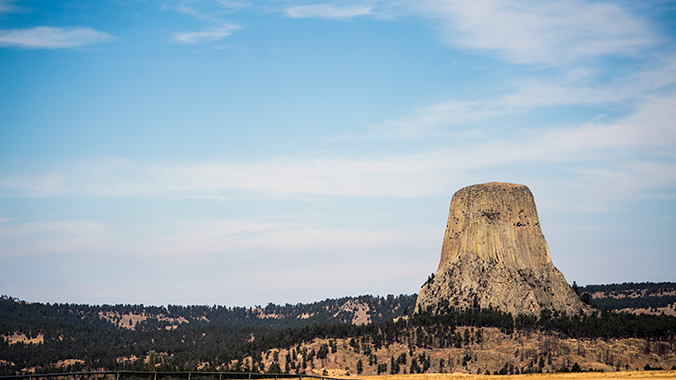South Dakota/Wyoming
On the Road: Mount Rushmore, Yellowstone and Grand Tetons
Program No. 20297RJ
Explore iconic monuments and national parks of South Dakota and Wyoming. From Mount Rushmore to Old Faithful, from the Mammoth Site to Little Bighorn Battlefield — it’s a big adventure!
Itinerary
While we make every effort to ensure the accuracy of our published materials, programs are typically advertised more than a year prior to their start date.
Read More.
While we make every effort to ensure the accuracy of our published materials, programs are typically advertised more than a year prior to their start date. As a result, some program activities, schedules, accommodations, personnel, and other logistics occasionally change due to local conditions or circumstances. Should a major change occur, we will make every effort to alert you. For less significant changes, we will update you during orientation. Thank you for your understanding.
Duration
10 days
9 nights
What's Included
20 meals (
8B, 6L, 6D
)
3 expert-led lectures
16 expert-led field trips
An experienced Group Leader
9 nights of accommodations
Taxes and customary gratuity
Road Scholar Assurance Plan
Day
1
Check-in, Orientation, Welcome Dinner
Location:
Rapid City, South Dakota
Meals:
D
Stay:
Doubletree by Hilton Rapid City Downtown Convention Center
Activity Note
Hotel check-in from 4:00 p.m. Remember to bring your nametag (sent previously).
Afternoon:
Orientation: 5:00 p.m. The Group Leader will greet everyone and lead introductions. We will review the up-to-date program schedule, discuss roles and responsibilities, logistics, safety guidelines, emergency procedures, and answer questions. We will learn from the Group Leader as well as local experts who will give lectures and lead field trips. Program-related travel and transfers will be via private motorcoach unless noted otherwise. This is a Road Scholar On The Road (OTR) program. OTR journeys take participants to multiple study sites within a region number of overnight stays. Lectures, talks, discussions, field trips, and on-board commentary enhance the program theme. Some journeys involve great distances and may take hours, others are much shorter. Long or short, On the Road journeys are learning experiences that make the most of our time together. There will be numerous opportunities for self-directed exploration to see and do what interests each of us most. Periods in the schedule designated as “Free time” and “At leisure” offer opportunities to do what you like and make your experience even more meaningful and memorable according to your personal preferences. The Group Leader will be happy to offer suggestions. Program activities, schedules, personnel, and indicated distances or times may change due to local circumstances/current conditions. In the event of changes, we will alert you as quickly as possible. Thank you for your understanding.
Dinner:
In our designated hotel meeting/dining room.
Evening:
At leisure. Continue getting to know your fellow Road Scholars, settle in, and get a good night’s rest for the day ahead.
Day
2
Rock Talk, Mount Rushmore, Crazy Horse Memorial, Custer Park
Location:
Rapid City, South Dakota
Meals:
B,L,D
Stay:
Doubletree by Hilton Rapid City Downtown Convention Center
Activity Note
Getting on/off a motorcoach with several steps up/down; approximately 4 hours riding time. Walking up to 2 miles; sidewalks, mostly even ground, slight inclines, boardwalks, 708 (354 one way) steps on elective 1/2-mile Presidential Trail at Mount Rushmore.
Breakfast:
At the hotel.
Morning:
We will be joined at the hotel by a local geologist who will give us a “rock talk” lecture on areas we will explore. Next, we will board a motorcoach for our field trip to iconic sites. At the Mount Rushmore National Memorial, the majestic 60-foot faces of four U.S. presidents gaze out over South Dakota’s Black Hills. Recognized worldwide, they stand as a symbol of American democracy. This national treasure tells the story of the United States’ rich history, rugged determination, and lasting achievement. From the Grandview Terrace, the views of George Washington, Thomas Jefferson, Theodore Roosevelt, and Abraham Lincoln are spectacular. We’ll learn why these four presidents were selected, see how the mountain was carved, and learn about sculptor Gutzon Borglum and the workers who brought Mount Rushmore to life. There will be opportunities to walk the half-mile Presidential Trail that loops along the base of the mountain and to learn more about history and see videos at the Information Center. We will continue to ride through the Black Hills to the Crazy Horse Memorial, where a fifth granite face has emerged in the Black Hills. In 1939, Lakota Chief Henry Standing Bear invited sculptor Korczak Ziolkowski to carve an Indian memorial in the Black Hills. Though Korczak died in 1982, the sculptor’s family continues the nonprofit project where the colossal mountain carving is now in progress. Crazy Horse is the largest sculptural undertaking ever, on a scale with the Egyptian pyramids. When completed, it will tower 563 feet high and 641 feet long. We’ll also have an expert-led exploration of the complex with some time to have a look around on our own.
Lunch:
At the historic Custer State Game Lodge.
Afternoon:
For our next field trip, we’ll ride to the Mammoth Site Museum in Hot Springs and explore with a museum expert. This 36,000-square-foot site is a one-of-a-kind “in situ” (in the original place) Ice Age museum containing the largest concentration of Columbian and Woolly Mammoths found in their primary context in the world. We will get a close-up view of the 26,000-year-old sinkhole where mammoths, bears, mountain lions, and wolves once walked. The Exhibit Hall features fascinating exhibits including a full-sized Columbian mammoth replica, a walk-in bone shelter, and skeletons of now-extinct carnivores such as a giant short-faced bear. We’ll also get a glimpse of scientific work being conducted in the state-of-the-art lab. The Mammoth Site has been featured on the CBS and NBC evening newscasts, the Discovery Channel, the Today Show, BBC television programs, and in many magazines including National Geographic. The site has co-hosted international symposiums and conferences, as well as published scientific Quaternary research books. En route back to the hotel, we’ll take a scenic drive through a portion of Custer State Park that covers 71,000 acres, making it one of the largest state parks in the nation. We’ll be on the lookout for some of the wildlife that may be resident here such as bison, pronghorn antelope, mule and whitetail deer, burros, coyotes, wild turkeys, elk, mountain goats, bighorn sheep, and golden eagles. Our Group Leader will provide commentary as we ride.
Dinner:
At the hotel in our private dining room.
Evening:
At leisure. You might like to use the fitness center, take a dip in the indoor swimming pool, soak in the hot tub, spend time with fellow Road Scholars, or just relax.
Day
3
Minuteman Missile, Badlands & Visitors Center, Wall Drug
Location:
Rapid City, South Dakota
Meals:
B,L
Stay:
Doubletree by Hilton Rapid City Downtown Convention Center
Activity Note
Getting on/off a motorcoach with several steps up/down; approximately 3 hours riding time. Walking over 2 miles; sidewalks, boardwalks, overlooks, mostly even ground, slight inclines.
Breakfast:
At the hotel.
Morning:
We will board our motorcoach for our first field trip of the day to the Visitor Center at the Minuteman Missile National Historic Site. With our Group Leader, we'll learn about the Intercontinental Ballistics system and the role it played in the Cold War — the period of geopolitical rivalry between the U.S. and the Soviet Union that lasted for decades. Moving on, we'll ride into Badlands National Park. The scenic drive through Badlands National Park is a mixture of rugged natural beauty, striking multicolored geologic deposits, and one of the world’s richest fossil beds. Some ancient mammals found within the Park include rhino, horse, saber-toothed cat, and pig-like creatures. The park owes its name to the natural conditions that make it hard to traverse and survive in, such as its jagged topography, harsh summers and winters, and dearth of potable water. Per the National Park Service, “For hundreds of years, the Lakota people have called this area mako sica, which literally translates to ‘bad lands.’ When early French fur trappers passed through this area, they called the area les mauvaises terres à traveser (‘bad lands to travel across’). Since the French trappers spent time with the Lakota, it is likely that the French name is derived directly from the Lakota one.” We will make several stops along the way at points of interest.
Lunch:
At a local restaurant.
Afternoon:
We will continue to journey through the beautiful Badlands National Park. We'll then visit Wall Drug Store, which became famous during the Depression for its free ice water, a tradition that continues to this day. We'll have some time to view the extensive Western Art collection that includes actual brands of local ranchers embedded in the wooden walls.
Dinner:
This meal has been excluded from the program cost and is on your own to have what you like. The Group Leader will be happy to offer suggestions.
Evening:
At leisure. Enjoy your evening out with a stroll and people watching, explore the “City of Presidents” in downtown Rapid City, or just relax at the hotel. Prepare for check-out and transfer in the morning.
Day
4
Transfer to Wyoming, Bighorn Mountains, Arrive Cody
Location:
Cody, WY
Meals:
B,L,D
Stay:
Holiday Inn Buffalo Bill Village
Activity Note
Getting on/off a motorcoach with several steps up/down; approximately 6-7 hours riding time, not including stops. Walking short distances.
Breakfast:
At the hotel.
Morning:
We'll check out of the hotel early morning, board our motorcoach, and depart Rapid City on our way to Cody, Wyoming, founded in 1901 by Colonel William F. "Buffalo Bill" Cody. As we ride, we'll have expert commentary on subjects such as state history, economics of the oil and coal industry, animals, and people who live in these wide open lands.
Lunch:
At the Sheridan, WY Visitor's Center, we'll have boxed lunches.
Afternoon:
Continuing our drive, we’ll cross the Big Horn Mountains and wind our way through beautiful countryside before arriving in Cody, Wyoming. The Bighorn Mountains and the Bighorn National Forest in north-central Wyoming have been explored by some of America's most famous pioneers, including Jim Bridger and Buffalo Bill Cody. It is land held sacred by the Cheyenne, Crow, Sioux, Arapaho, and Eastern Cheyenne Indians — a land of much spilled blood where Native Americans fought some of their most desperate battles with the U.S. military. We expect to arrive in Cody in the late afternoon and check in at our hotel. Before arrival, we’ll hear about elective evening activities.
Dinner:
Tonight we will receive vouchers to choose from a variety of local restaurants. The Group Leader will be happy to offer suggestions.
Evening:
At leisure. You might like to watch the free Cody Gunfight performance in front of Buffalo Bill’s historic Irma Hotel, attend the Cody Nite Rodeo (June-August), or just experience Main Street’s sights and sounds that harken back to the Old West.
Day
5
Buffalo Bill Museum & Dam, Yellowstone National Park
Location:
West Yellowstone
Meals:
B,L
Stay:
Clubhouse Inn
Activity Note
Getting on/off a motorcoach with several steps up/down; approximately 4 hours riding time with stops throughout the day. Self-paced walking from 4 blocks to approximately 1 mile; level surfaces, boardwalks, some inclines, up to 30 steps in places.
Breakfast:
In the hotel dining room.
Morning:
We will board the motorcoach and ride to the Buffalo Bill Center of the West for a self-directed exploration. The museum was founded in 1917 to preserve the legacy and vision of Col. William F. Cody. The Center is the oldest and most comprehensive museum of the West with collections containing more than 34,977 artifacts, 20,000 books, and 260,000 photo archives. The Center consists of the Harold McCracken Research Library, dedicated in 1980, and five separate museums: The Whitney Western Art Museum, established in 1958 and dedicated in 1959; the Buffalo Bill Museum, established in 1927, dedicated in 1969; the Plains Indian Museum, 1969; Cody Firearms Museum, dedicated in 1976; the Draper Museum of Natural History, dedicated in 2002. Next, we'll make a short stop at the Buffalo Bill Dam and Visitor Center where a local expert will give us a talk. It was originally called the Shoshone Dam. Drilling to find bedrock for the foundation began in the spring of 1904. More than 82,900 cubic yards of concrete were used to build the dam, and seven men were killed during construction. When completed in 1910, it was the tallest dam in the world with a final cost of $929,658. The dam is listed on the National Register of Historic Places, has been documented by the Bureau of Reclamation, and included in the National Park Service's Historic American Engineering Survey. Moving on to Yellowstone National Park, we'll enter via the East Entrance.
Lunch:
We will stop at Buffalo Bill Cody's old hunting lodge, now known as Pahaska Tepee, and enjoy a sack lunch en route upon departure.
Afternoon:
We will continue driving along the Yellowstone River to Hayden Valley: a favorite place to watch for animals such as bison, elk, deer, once-in-a-while bear, and birds such as osprey, eagles, Canada Geese, and pelicans. We’ll also look for thermal features such as mud pots and steamy “dragon” springs as well as colors of the Grand Canyon of the Yellowstone with its spectacular Upper and Lower waterfalls. Yellowstone National Park is known for the most geysers in the world. About 2 million years ago, huge volcanic eruptions occurred here and the park’s present central portion collapsed, forming a 30-by-45 mile caldera, or basin. The magmatic heat powering those eruptions still today powers the park's geysers, hot springs, fumaroles, and mud pots, all of which we will have opportunities to see. Waterfalls at the Grand Canyon of the Yellowstone highlight the boundaries of lava flows and thermal areas. One 19th-century visitor, Nathaniel Lanford, wrote: “As I took in the scene, I realized my own littleness, my helplessness, my dread exposure to destruction, my inability to cope with or even comprehend the mighty architecture of nature.” We expect to check in at the hotel in the early evening when we’ll adjourn for the day.
Dinner:
On your own to enjoy local fare. There are numerous dining choices in walking distance of the hotel.
Evening:
At leisure. Enjoy the rest of your evening strolling West Yellowstone or just relaxing at the hotel. Prepare for check-out and transfer in the morning.
Day
6
Yellowstone Park, Fountain Paint Pots, Old Faithful Geyser
Location:
Grand Teton National Park and Jackson Hole Valley Wyoming
Meals:
B,D
Stay:
Jackson Lake Lodge
Activity Note
Getting on/off a motorcoach with several steps up/down several times throughout the day; approximately 3-4 hours riding time. Walking from approximately 1/4 mile to 1 mile at several sites; sidewalks, boardwalks, and indoors.
Breakfast:
In the hotel hospitality room.
Morning:
After checking out of the hotel, we will board a motorcoach and drive from West Yellowstone to Old Faithful area along the Gibbon and Firehole Rivers to the Fountain Paint pots. With our Group Leader, we will follow the boardwalk to observe several types of thermal features including mud pots, hot springs, geysers, fumaroles, steam vents, and bacteria mat — all within one half-mile. We’ll then ride to Old Faithful, the world’s best-known geyser. Its eruptions vary at intervals from 40 to 126 minutes. Park Rangers will be available during our self-directed exploration. There are many boardwalks to explore the geyser basin around Old Faithful. During your self-directed exploration, you might like to visit the Old Faithful Visitor Education Center and see exhibits on hydrothermal features, life in extreme environments, and the Greater Yellowstone region’s volcanic geology. The center has information and maps regarding Ranger programs, Ranger-led walks, and talks.
Lunch:
On your own to enjoy what you like in the Old Faithful area. Choices within walking distance include the cafeteria in the Old Faithful Lodge dining room, a bar and grille, and a deli shop.
Afternoon:
Continuing our self-directed exploration, you might like to hear some of the Ranger presentations and/or walk through the Historic Old Faithful Inn on your own and hear from a hotel expert. Built during the winter of 1903-04, the Inn was designed by Robert Reamer and is a designated National Historic Landmark. It is a masterpiece of rustic architecture reflecting the chaos of nature. The building is a rustic log and wood-frame structure with gigantic proportions. The lobby features a 65-foot ceiling, a massive rhyolite fireplace, and railings made of contorted Lodgepole pine. Mid- to late afternoon, we will reboard our motorcoach and ride through the south gate to Grand Teton National Park along the Rockefeller Parkway that connects Yellowstone and Grand Teton at the heart of the Greater Yellowstone ecosystem. The late conservationist and philanthropist John D. Rockefeller, Jr. made significant contributions to several national parks including Grand Teton, Acadia, Great Smoky Mountains, and Virgin Islands. We expect to check in to the lodge late afternoon.
Dinner:
At the Historic Jackson Lake Lodge.
Evening:
At leisure. You might like to take a walk, swim in the outdoor heated pool (June-August), watch for wildlife, or just relax in the Grand Lobby of the Lodge. Check the lobby information board for special evening presentations or activities.
Day
7
Grand Teton National Park, Free Time
Location:
Grand Teton National Park and Jackson Hole Valley Wyoming
Meals:
B
Stay:
Jackson Lake Lodge
Activity Note
Getting on/off a motorcoach; approximately 2 hours riding time. Walking up to 1 mile; sidewalks, paved areas. Extent and duration of walking and other activities during free time according to personal choice.
Breakfast:
At the historic Jackson Lake Lodge
Morning:
We will board the motorcoach and travel along the scenic loop road of the Tetons. As we ride, there will be opportunities to enjoy the breathtaking beauty of the mountains at several picture stops and Jenny Lake. We’ll then arrive at Craig Thomas Visitor Discovery Center for a self-directed overview of the history, culture, and geology of the Tetons. Next, we’ll ride to the town of Jackson.
Lunch:
On your own to have what you like in the town of Jackson. The Group Leader will be happy to offer suggestions. Back on the motorcoach, we expect to return to the lodge by approximately 1:30 p.m.
Afternoon:
Free time. This period of time has been set aside for your personal independent exploration to see and do what interests you most. Please refer to the list of Free Time Opportunities. The Group Leader will be happy to offer suggestions. Go for a walk and watch for animals and birds, take in the majestic view of the Teton Mountains, or just relax. Grand Teton National Park is located in northwestern Wyoming and comprises more than 310,000 acres of unique landscapes rich with breathtaking lakes, majestic mountains, alpine terrain, and extraordinary wildlife. The infamous Jackson Hole sits at the foothills of the Tetons Mountain range and is a popular destination for millions of visitors each year with its Western character and small-town charm. Please note that the period scheduled for free time is subject to change depending on local circumstances and opportunities for independent exploration.
Dinner:
On your own to explore dining choices at Jackson Lake Lodge.
Evening:
At leisure. Check the lobby information board for special evening presentations or activities. Prepare for check-out and transfer in the morning.
Day
8
Yellowstone NP, Heart Mountain Internment Camp
Location:
Billings, Montana
Meals:
B,L,D
Stay:
Hampton Inn & Suites
Activity Note
Getting on/off a motorcoach; approximately 4-5 hours riding time including a stop. Walking up to 1/2 mile; paved sidewalks.
Breakfast:
At the historic Jackson Lake Lodge.
Morning:
After checking out of the hotel, we'll board the motorcoach and set out through Yellowstone National Park and into the town of Cody, WY.
Lunch:
In the town of Cody, we'll have lunch at a family-owned restaurant.
Afternoon:
After lunch, we will board the motorcoach and travel to Heart Mountain Japanese Internment WWII Camp where through photographs, artifacts, oral histories, and interactive exhibits at the Interpretive Center you will experience life at Heart Mountain through the eyes of those Japanese and Japanese Americans who were confined here during WWII. The Interpretive Center provides an overview of the wartime relocation of Japanese Americans, including the background history of anti-Asian prejudice in America and the factors leading to their enforced relocation and confinement. Special emphasis is given to the experience of incarceration, the diverse personal responses of Japanese Americans to their imprisonment, constitutional issues, violations of civil liberties and civil rights, and the broader issues of race and social justice in the U.S. We will check in at the hotel late afternoon.
Dinner:
At a local restaurant.
Evening:
At leisure. Prepare for check-out and transfer in the morning.
Day
9
Little Big Horn & Devils Tower Natl' Monuments
Location:
Rapid City, South Dakota
Meals:
B,L,D
Stay:
Doubletree by Hilton Rapid City Downtown Convention Center
Activity Note
Getting on/off a motorcoach; approximately 5-6 hours riding time including stops. Walking approximately 2-4 miles; paved path, one steep incline at Devils Tower followed by several gentle inclines.
Breakfast:
In the hotel hospitality room.
Morning:
We’ll check out of the hotel and begin our journey to the Little Bighorn Battlefield National Monument, which was first set aside as a National Cemetery, memorializing the soldiers of the 7th Cavalry Regiment who died in the 1876 battle. Over time, interpretation of the battle and the participants on both sides spurred the designation of a national monument in the 1940s. Today the National Park Service manages the site to protect its cultural and historic resources for future generations. The history of this battlefield park is a sum of the people involved with the battle, the places where the fighting occurred, and the stories which connect these tangible elements. Of course, the primary story is of the battle itself.
Lunch:
Boxed lunch en route.
Afternoon:
Continuing our adventure, we’ll carry on by motorcoach to Devils Tower National Monument. The National Park Service website states: “The Tower is an astounding geologic feature that protrudes out of the prairie surrounding the Black Hills. It is considered sacred by Northern Plains Indians and indigenous people.” About 60 million years ago, molten magma was forced into sedimentary rocks above it and cooled underground. As it cooled, it contracted and fractured into columns. President Theodore Roosevelt designated Devils Tower as America’s first national monument in 1906. It was a key feature in the 1977 movie ‘Close Encounters of the Third Kind.’ We’ll take a walk around the base of Devils Tower on a paved path with medium to steep incline the first 1/8 of a mile, followed by a combination of flat and gentle inclines the rest of the 1.5-mile paved trail. Those who prefer to watch and wait are welcome to do so at the small Badlands Visitor Center. The final leg of our ride back to Rapid City will take approximately two hours. Watch for various kinds of animals while traveling across wide-open spaces. How many jackrabbits, deer, pronghorn, and coyotes can you spot among the miles of Artemisia Tridentata (more commonly called Wyoming Big Sagebrush)? The song “Lonesome Cowboy” expresses what it means to be cowboy ranchers who tend their sheep and cattle in this part of the state where the nearest neighbor might be 20 miles away. We expect to arrive at the hotel late afternoon for check-in. Be sure to make arrangements with the hotel front desk staff for the shuttle to the airport in the morning.
Dinner:
In our private hotel dining room. Share favorite experiences and enjoy camaraderie with new Road Scholar friends during our farewell dinner.
Evening:
At leisure. Prepare for check-out and departure in the morning.
Day
10
Program Concludes
Location:
Rapid City, South Dakota
Activity Note
Hotel check-out by 11:00 a.m.
Breakfast:
On your own. This concludes our program.
Morning:
If you are returning home, safe travels. If you are staying on independently, have a wonderful time. If you are transferring to another Road Scholar program, detailed instructions are included in your Information Packet for that program. We hope you enjoy Road Scholar learning adventures and look forward to having you on rewarding programs in the future. Don't forget to join our Facebook page and follow us on Instagram. Best wishes for all your journeys!
Please select a day to update the map
Map details are not available for this location.

